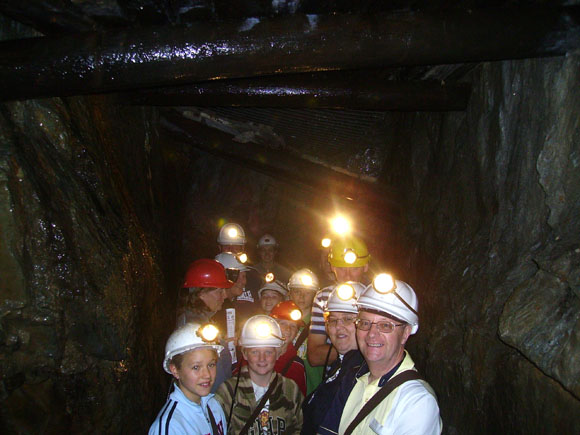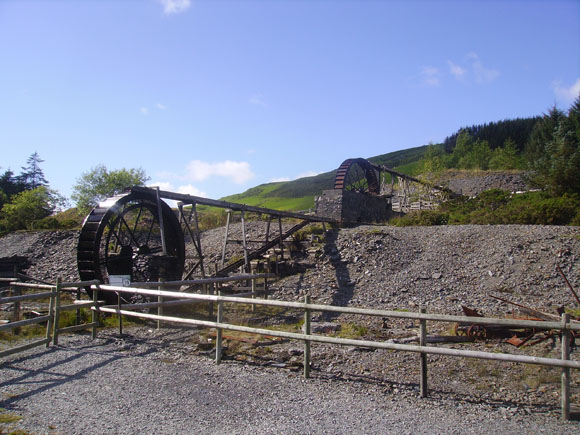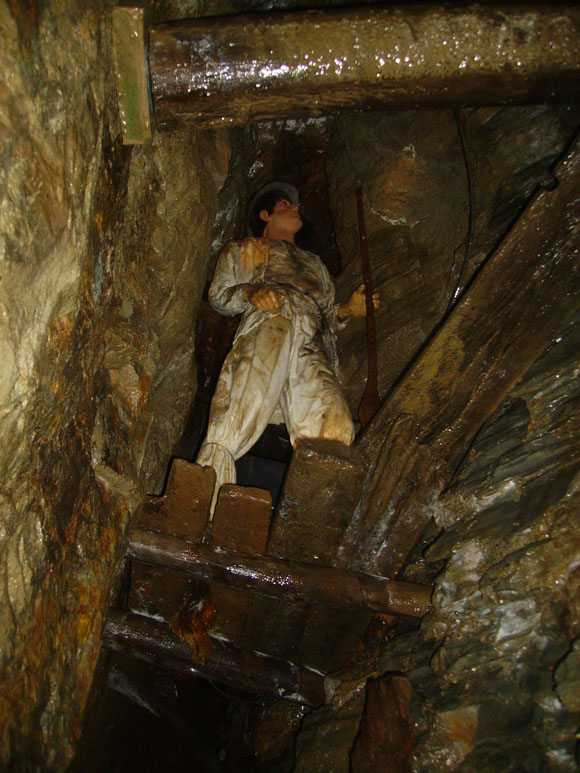|
Llywernog Silver Lead Mine, Mid-Wales (as featured on Country File 2009)
The history of Llywernog Mine
The mine was known locally as Gwaith Poole, (Poole's Minework). The original discovery of the mineral vein was made around the year 1742, during the reign of King George III. The names of the original prospectors are not known but they would have possessed a Mining License or 'Tack Note' issued by the Agent of the Gogerddan Estate on behalf of Sir Lewis Pryse, the 'Mineral Lord'.
The first workings consisted of two shallow shafts connected by a level driven along the lode. The location of the early trials was in woodland, southwest of the great 'opencut'; visible on the present 'Miners Trail'. By 1790, two 'adits' or levels were being blasted into the hillside using techniques of hand-drilling and gunpowder charges. Both of those original tunnels are now accessible to visitors.
One tunnel struck the 'Main Lode' of silver-lead ore (technically known as 'Argentiferous Galena') at a depth of 17m below the surface outcrop and a productive period of activity began. The other adit, driven further to the east was a disappointment, and cut only a minor lode with little or no ore visible. This tunnel now forms part of the 'Miners Trail' and is known as 'Balcombe's level', named after James Barton Balcombe, Managing Director of the Llywernog Silver-Lead Mining Company in 1870.
1973
During 1973, the old mine was awoken from its slumbers and began life as a mining museum, privately developed by a young mining historian Peter Lloyd Harvey, and his father, the late Dr Stephen Harvey of the University of Leicester. Now, the Museum is still evolving and the traditions of the old mining district live on for future generations. Llywernog mine was mined for Galena, a mixture of Silver and lead, and although silver is more expensive than lead, it was the lead that was in great demand at the time, so it was extracted and the silver was the ‘impurity’. Another mineral commonly found in mines in the area was Iron Pyrite, or Fools Gold.
2009
Currently, the mine offers two different types of tours to visitors; an above ground, self-guided tour, on which visitors are given a map and follow a guided trail, and an underground guided tour. The self-guided tour visits various exhibitions allows visitors to explore a small tunnel, Balcombs level (which has a working post-box at the end!!), by themselves, have a go at panning for gold, and watch 2 DVD shows along the way.
The underground guided tour runs every hour or so. The visitors are kitted up with head lamps and helmets, and are taken into the ‘earthquake zone’, and main mine shaft by a guide. On the tour, visitors are told about the general history of the mine, given a sound and light show, and hear about the old miners tales about the mischievous creatures that lived in the mines.
Our main exhibition area is in the old mine ‘Count House’ of 1871 with old photographs, tools and mining documents from this industry. Many of the artefacts were found whilst clearing the levels of the mine.
The shop & Cafe
There is also a shop and café on site. The café serves hot and cold drinks, homemade cakes, snacks, sandwiches, pasties, and a warm reception from the cool temperatures of the mine! The gift shop specialises in inexpensive mineral specimens, crystals, silver jewellery, genuine miners’ lamps, gold pans, books, maps and mining souvenirs.
Awards
The quality of Llywernog mine and the restoration work has won the ‘Prince of Wales Award’ and the ‘Association for industrial archaeology’ gave us our very first conference award. The mine has been praised by the ‘Good museum guide’ in the past when they said that Llywernog was “One of the best commercial museums in Britain”.
Famous Visitors
We have had a few famous visitors over the years, including David Bellamy, who is a botanist, writer and broadcaster. The mine is often used for television programmes and has frequently been featured on S4C (Welsh channel 4), and also in many holiday and historical programmes. Most recently, however, the mine was featured on the popular BBC1 show Country File. John Craven visited the mine and explored the caverns with a film crew, also conducting an interview with Peter Lloyd Harvey.
Llywernog mine is also twinned with Poldark mine in Cornwall.
Location
Llywernog Silver-Lead mine is situated in Mid-Wales in the wild welsh hills. It’s a 15 minute drive from Aberystwyth on the A44.
 For further information including opening times, special offers and further details please visit: For further information including opening times, special offers and further details please visit:
http://www.Silverminetours.com
|




